As your company grows, you can’t possibly spur on each individual person in your organization to stay on task. You can’t be chief cook and bottle washer! As we say at EOS, you’ve got to “Let Go of the Vine!”
The good news is that you can dramatically improve accountability with a framework that can be built into the DNA of your company by creating a culture of accountability.
Accountability thrives in the right culture. Employees want accountability for themselves and their co-workers because it improves morale when people do what that say, versus dropping the ball. Accountability and culture go hand-in-hand.
Without accountability, there are inconsistencies, redundancies, inefficiencies and train wrecks. Everything takes more time and costs more. One week all is well, and the next week everything falls apart. Sound familiar?
Here are some simple principals and tools to help you built a culture of accountability:
Accountability Chart. It all starts with creating clarity around the major functions of the organization and who is accountable for what. In the EOS system, we use an Accountability Chart to clarify the major functions of an organization and identify the primary roles and responsibilities of each seat.
Whether there is a customer service problem or there’s no toilet paper in the facility, you’ll save time and energy if employees aren’t forced to guess who owns the problem. The key is only one person is responsible for each major function of the company, because if everyone is responsible, then no one is responsible!
Vision and Goals. Once you’ve created the right structure through the Accountability Chart, then you are equipped to pursue your strategic goals. In the EOS system, this is your Vision Traction Organization – or VTO – a high-level strategic plan meant to be shared with the entire company. A shared Vision supports a culture of accountability, with everyone crystal clear on where the company is going and how it’s going to get there.
Core Values. A key component of the VTO is your Core Values. Your Core Values are “who” you are – guiding principles, fundamental beliefs or standards of behavior. They help build a culture of accountability by reinforcing the right attitudes and behaviors.
A poster on the wall and an occasional mention at a meeting will not build a culture of accountability around Core Values. Once identified, you’ve got to hire, fire, review, reward, celebrate, communicate and coach on Core Values, so they are dialed into the DNA of your organization.
Core Focus. Another critical component of your VTO is your Core Focus – your Purpose, Cause or Passion. It’s “why” your business exists – its mission in the world, combined with your business niche, the one thing, either a product or service, your company can excel at offering.
Today’s employees want to be part of something bigger than themselves and they want to find meaning in their work. Yes, they are still interested in fair pay and benefits, but they also want to be part of an organization that makes a difference in the world. If employees are excited about being part of something great, they’re likely more accountable because they genuinely care!
If your people are not excited by the Core Focus, it’s probably because you and your leadership team are not excited about your Core Focus! If you’re not excited about it, go back to the drawing board, dig deep and find your why.
Besides, it just happens to be a huge business advantage. In “Grow: How Ideals Power Growth and Profit at the World’s Greatest Companies,” author Jim Stengel shows how companies with a strong mission and employee buy-in outperform their competition by 400%!
A company’s Core Focus also protects you and your leadership team from the “shiny stuff” that gets you off track from your stated goals and strategies, spreads you too thin, and dilutes accountability across the organization. One of the top reasons for lack of accountability is competing priorities, with employees experiencing organizational whiplash as the owners and leaders change direction.
Clear Direction. Finally, to ensure everyone is on the same page with where the company is going and how it’s going to get there, the VTO lays out long-term goals, annual goals and quarterly Rocks, so that the entire organization can build a culture of accountability around a common understanding of the direction of the company with employees who buy into the Vision!
Beyond the VTO, there are additional accountability tools that keep the entire organization rowing in the same direction.
Scorecard. In the EOS system, the Scorecard identifies the right set of 5 to 15 leading indicators that provide an absolute pulse on the business or a department. This tool helps facilitate a culture of accountability for 3 reasons:
1. Provides clarity for leaders and employees on what management expects.
2. Frees up management to focus on future opportunities, strategies, relationships and other high value activity.
3. Identifies issues early on, so leaders and managers have the opportunity to get back on track before the quarter ends – when it takes more time and usually costs more.
Systems and Processes. If your organization has poor processes, it leads to frustration that negates building a strong culture of accountability. When it’s common to drop the ball, it affects morale. If everyone is doing their own thing and they see others ignoring the processes, they start thinking, “Why Bother?!”
By establishing your Core Processes, high-level checklists of the flow of work in the main areas of operations of your company – HR, Finance, Marketing, Sales, Operations, Customer Service, Project Management, etc. – inconsistencies and wasted effort is eliminated, and employees start saving time and energy.
It is essential that employees be involved in defining the best way to do their job. They have insights the owner and leadership team members may not have. Being involved also creates buy-in to the process.
When finished, from top to bottom, everyone in the company is on the same page, following the right and best way, with a continuous improvement mindset – and increased individual and organizational efficiency that makes a positive impact to the bottom line.
Meeting Pulse. Another tool critical to building a culture of accountability is having a regular meeting pulse. In the EOS system, the Meeting Pulse includes:
1. Annual Planning Sessions (executive teams and department teams), to learn from the past year, conduct a SWOT Analysis to determine strategy, set new goals for the next year, knock down issues that could be barriers to a successful year, and build team health.
2. Quarterly Sessions to re-set priorities, knock down issues and built team health (executive teams and departmental teams).
3. Weekly Level 10 Meetings to keep priorities on track and reduce issues that impede progress (executive teams and departmental teams).
4. “Same Page” Meetings to keep leaders aligned and cohesive (visionary and integrator, 1-3 meetings per quarter).
A healthy Meeting Pulse supports a culture of accountability because it keeps everyone on track, preventing fragmentation. Without regular meetings, there is a domino effect with teams no longer having clear direction and losing traction in the business, causing the wheels to spin out of control. A lack of connection also implies disinterest that can lead to poor performance or worse, good people leaving your company!
Encouragement. If you struggle with holding people accountable, get started now! With all the above tools, you have all the pieces it takes to build a strong culture of accountability.
When done right, accountability is a byproduct of great leadership and management. It doesn’t have to be forced. Think of it as this simple equation:
Great Leadership + Great Management = Accountability
The key is to just stay focused and consistent. Please contact me if you get stuck or have questions. Over time you’ll see your people delivering on their commitments and your operations becoming easier and more profitable!
